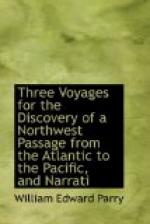At nine A.M. on the 2d, Lieutenant Reid and his party were descried at their landing-place, and a boat being sent for them, arrived on board at half past eleven. He reported that the ice seemed to extend from Amherst Island as far as they could see to the westward, presenting one unbroken surface from the north to the south shore of the strait.
Notwithstanding every exertion on the part of our travellers, their labours had not thrown much light on the geography of this part of the coast, nor added any information that could be of practical use in directing the operations of the ships. The important question respecting a second passage leading to the westward still remained as much a matter of mere conjecture as at first; while the advanced period of the season, and the unpromising appearance of the ice now opposing our progress, rendered it more essential than ever that this point should, if possible, be decided. Under this impression it occurred to me, that the desired object might possibly be accomplished by pursuing the route along the head or western shore of Richards’s Bay, part of which I had already traversed on my former journey, and found it much less laborious walking than that experienced by Captain Lyon on the higher and more rugged mountains inland. I determined, therefore, to make this attempt, taking with me Mr. Richards and most of my former companions.
This night proved the coldest we had experienced during the present season, and the thermometer stood at 24 deg. when I left the ships at four A.M. on the 3d, having previously directed Captain Lyon to remain as near their present station as might be consistent with safety, and carefully watch for any alteration that might occur in the western ice.
Being favoured by a strong northwesterly breeze, we reached the narrows at half past six A.M., and immediately encountered a race or ripple, so heavy and dangerous that it was only by carrying a press of canvass on the boat that we succeeded in keeping the seas from constantly breaking into her. This rippling appeared to be occasioned by the sudden obstruction which the current meets at the western mouth of the narrows, aided, in the present instance, by the strong breeze that blew directly upon the corner forming the entrance on the south side.
Having landed at Cape Northeast, I made sail for the isthmus at ten A.M., where we arrived after an hour’s run; and hauling the boat up on the rocks, and depositing the greater part of our stores near her, set off at one P.M. along the shore of Richards’s Bay, being equipped with only three days’ provision, and as small a weight of clothing as possible. The coast, though not bad for travelling, led us so much more to the westward than I expected, in consequence of its numerous indentations, that, after above five hours’ hard walking, we had only made good a W.S.W. course, direct distance six miles. We obtained on every eminence a distinct view of the ice the whole way down to Neerlo-nakto, in which space not a drop of clear water was discernible; the whole of Richards’s Bay was filled with ice as before.




